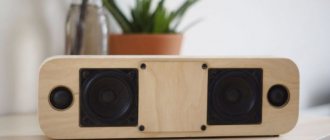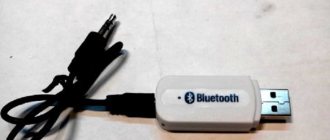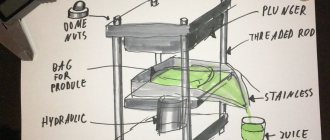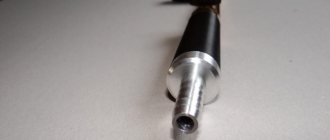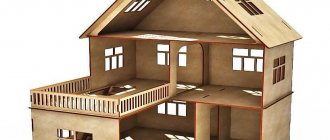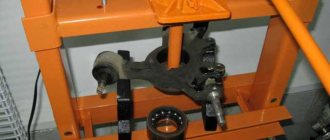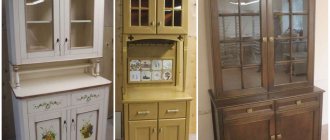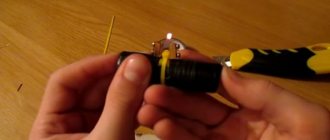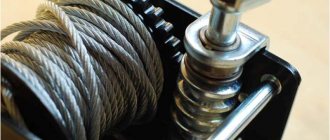I made a powerful boombox speaker for my garage, and wrote an article on how to make acoustic speakers with your own hands. The body is made of fiberboard 2 cm thick, and the Truck Bed Liner was used for painting. The result is simply magnificent. All efforts to connect electronics will be in vain if no one sees and appreciates the result, so I made a hole in the case, covered with plexiglass.
I placed buttons and switches on the surface of this window. The boombox also has a power connector and a 3.5 mm audio jack, so you can connect any sound source. You can connect a guitar or microphone to the amplifier, it allows this.
Materials for making a homemade speaker system:
- Fiberboard sheet 2 cm thick
- A piece of plexiglass
- Wood glue
- A set of sheets of sandpaper of different abrasiveness
- Wood screws of different sizes
- Speakers (for low frequencies I took 20 cm speakers, for high frequencies - 16.5 cm speakers)
- Amplifier
- Self-resetting switches (optional)
- High quality wires
- Heat shrink tube 3mm (color of your choice)
- Solder
- Clamps
- Paint can Truck Bed Liner
- Can of primer paint
Peculiarities
A boombox is a small but powerful music speaker that has a separate power source. To create it, the following is required.
- Board 18 mm thick.
- 5 mm plywood (external front panel).
- 12 mm plywood (back panel).
- Background pipe 42 mm.
- Plexiglass.
- Fasteners (screws, furniture confirmations).
- Wood glue and super cement glue.
- Solder.
- Paint in a can.
- Clamps.
- The battery is 12 volt, 7.3 A/h (it can be taken from the laptop power supply).
Recharging 1 Ah. The sound is played from the Pioneer MV 194 UB car radio. The speakers are AV PB-64.2. Dimensions 152 x 192 x 642 mm. Weight 6.5 kg. You can take speakers for high frequencies - 17 cm, for low frequencies 22 cm. You should pay attention to the wiring coming from the linear output. It’s better to install shielded wiring and move the power supply away. It is permissible to think about increasing the volume of the container (box) itself. Some masters place cotton wool or a bag filled with foam rubber in the space, then the sound can change for the better.
The holes for the speakers are cut with a router, and the angle can be up to 46°.
It is important to calculate the correct dimensions of the panels so that they match and there are no distortions.
When gluing panels, it is recommended to use clamps; the back cover is mounted at the end, after all the wiring has been installed. The plywood body is treated with a universal bactericidal primer before painting.
The best inexpensive boomboxes
First of all, we will consider the most inexpensive boomboxes, which have the best combination of price, functionality and characteristics. You can easily find many even cheaper models on the market, but they are mostly much inferior to these in important parameters.
Defender G104, 12 W, black
Rating: 4.4
First, let's look at the most budget boombox from the Russian brand Defender. As often happens, the manufacturer tried to compensate for some technical compromises with additional functionality, and for the most part the company succeeded.
Defender G104 is equipped with two speakers with 6W power each. At the same time, the sound is still single-channel, that is, mono. But this is not too much of a problem, since the speaker itself is small, and by definition you should not expect expressive surround sound from it.
But the sound itself is good, the signal-to-noise ratio is 70 dB, and there is a good volume reserve. Frequency range coverage - from 70 to 18 thousand Hz.
The boombox can be connected to a sound source via Bluetooth or wired through a 3.5 mm minijack input. You can also connect a USB flash drive with music or a microSD memory card. The interfaces are located at the top, for which many users are grateful to the developers - it’s just convenient.
In addition, the device is equipped with a built-in FM tuner. Radio stations are displayed on the display, and tracks read from memory cards are also displayed there. Defender G104 recognizes folders and reads files not only from the root of the flash drive.
The design of the boombox is bright and eye-catching, and the speaker areas are equipped with backlighting. The plastic of the case is not particularly remarkable, but the assembly is quite strong.
From a review of a confirmed purchase on Yandex.Market by a user with the status “Gadget Inspector Level 2”: “Multimedia connectors are on top (easily accessible). Reads music in folders. Compact size, light, loud enough, perfect for a picnic.”
Advantages
- fairly clear and loud sound;
- built-in display;
- support for flash drive and microSD;
- built-in FM tuner;
- convenient location of connectors;
- spectacular appearance with lighting.
Flaws
- Some users experience noise when charging at the same time.
SVEN PS-465, 18 W, black
Rating: 4.5
Next, we will consider a variant of the well-known SVEN brand in Russia. This boombox is only 500 rubles more expensive than the previous one, but it has noticeable advantages.
Firstly, here we already see full stereo. True, you shouldn’t delude yourself with a couple of additional small minion speakers - this is a fake decoration. The total power of the speakers is 18W, but in fact it may not be enough as the battery discharges. But the sound is still noticeably better and louder than the previous model.
It has its own battery, quite capacious - 1800 mAh, the boombox can work for up to 5-6 hours on one charge. Charging is via a USB cable, it is included in the kit.
You can connect to the speaker via Bluetooth; the radio module supports HSP, HFP, A2DP, AVRCP profiles. There is also a standard minijack audio jack. There is a microSD card slot. There is an FM radio and a bass/treble control. Tracks and stations are displayed on the built-in LED display.
The design of the boombox is more restrained, but far from passable, but well-designed, expressive, users like its certain brutality. The case is strong, made of not particularly expensive, but high-quality and durable ABS plastic.
Advantages
- high-quality sound in its class;
- Bluetooth supports A2DP and other popular profiles;
- LED display;
- FM radio;
- good autonomy;
- "brutal" design.
Flaws
- When turned on, it can play at high volume.
Ginzzu GM-984G, 20 W, black
Rating: 4.6
And the selection of inexpensive boomboxes will be completed by a model from the famous Taiwanese brand Ginzzu. This model is better in all respects than both of those described above; at Russian points of sale at the beginning of 2022, it costs about 3 thousand rubles.
The model is even more powerful than the previous one - a total of 20W for both speakers. Full stereo, passive subwoofer provides good lows. Signal to noise ratio - 65 dB.
Wireless signal transmission occurs via high-speed Bluetooth 5.0. In addition, there is a connector for a USB Type-A flash drive, a slot for a microSD memory card, and a 3.5 mm minijack audio input. Built-in FM tuner. There is even a TWS mode that allows you to connect additional acoustics via Bluetooth, creating a stereo pair with a boombox.
We also need to praise this model for its water resistance. It is basic - IPX5, that is, it only protects against splashes, but in case of sudden rain in nature, this will save the electronics of the device.
As for battery life, it is excellent here. The capacity of the built-in battery is 3000 mAh. The stated 5 hours of work means the manufacturer is even showing modesty. Tests show that the boombox can easily work non-stop for 6 hours at almost maximum volume, and much longer at medium volume.
The boombox is also good in appearance - the design is elegant, stylish, dynamic RGB lighting with effects. Some users complain about audible noise when the backlight is on, but it can be turned off if desired.
Advantages
- high-quality sound;
- fairly pronounced lows - passive subwoofer;
- TWS mode;
- Bluetooth 5.0;
- decent autonomy;
- IPX5 splash protection;
- Elegant design and switchable backlight.
Flaws
- There is some noise when the backlight is on.
Necessary materials
To make a boombox from a car radio that has served its useful life, it is recommended to first remove the speakers. For this you need:
Tools needed:
- drill;
- Bulgarian;
- screwdrivers (plain Phillips);
- scissors, knife;
- wire cutters;
- pliers;
- glue;
- self-tapping screws, “3” mm bolts.
The power of each speaker can be 5 watts each, have 4 ohms. The speakers are fixed in a new housing, which can be made from a cardboard box. It is possible to make a container from an aluminum-wooden suitcase; it once contained a set of Chinese modules. Some craftsmen make the body out of plywood. What is needed to make a boombox from an old radio:
- speakers from 2 to 6 pieces;
- box;
- amplifier;
- Li-pol charger;
- switch;
- indicator showing the charging level.
First, points are marked for the speakers. Drill "3" makes holes. We install the speakers using 3 mm bolts. We install the drivers. Holes for mounting are cut into the body:
- indicator;
- power buttons;
- volume control;
- sound jack, which supplies an audio signal;
- connector, it provides charging for the lithium device.
It is important to ensure that all parts are tightly secured and that there are no gaps in the housing. It is recommended to pay special attention to the joints. It is good to use silicone to seal excess holes; it securely fixes and creates a reliable seal of the container.
Now it’s time for the electronic filling. We install a button on the battery tester, it will light up during operation. Another resistor (1 kOhm) is mounted on the switch, then the backlight can work and will be clearly visible . A connector for the jack is soldered into the board, we switch the wires to the jack of the future boombox.
The amplifier is connected to a 12 volt charger. The fan is soldered directly to the amplifier connector. The potentiometer can be further extended using a cable. All parts are placed in a container. Some elements can be secured with tape or sealed with glue.
We assemble speakers from 4 to 6 pieces, each with 4 ohms. We connect all audio units to one two-channel amplifier. Option one: turn off the speakers sequentially (we connect the minus of the first speaker to the “+” of the second, then the minus of the second with the plus of the third, etc.). In the end, the total will be 24 ohms - this is a lot, it is necessary to reduce the parameters.
If connected in parallel, the resistor will be extremely small, which does not always meet the necessary requirements. Therefore, it is necessary to combine elements. The total power will be about 30 watts. If two channels are connected, the power will be increased. As you can see, if we are assembling a homemade boombox from a car radio, then there should be no difficulties, this product is structurally simple.
How to make acoustic speakers with your own hands - assembling a homemade boombox system
I made a powerful boombox speaker for my garage, and wrote an article on how to make acoustic speakers with your own hands. The body is made of fiberboard 2 cm thick, and the Truck Bed Liner was used for painting. The result is simply magnificent. All efforts to connect electronics will be in vain if no one sees and appreciates the result, so I made a hole in the case, covered with plexiglass.
I placed buttons and switches on the surface of this window. The boombox also has a power connector and a 3.5 mm audio jack, so you can connect any sound source. You can connect a guitar or microphone to the amplifier, it allows this.
Materials for making a homemade speaker system:
- Fiberboard sheet 2 cm thick
- A piece of plexiglass
- Wood glue
- A set of sheets of sandpaper of different abrasiveness
- Wood screws of different sizes
- Speakers (for low frequencies I took 20 cm speakers, for high frequencies - 16.5 cm speakers)
- Amplifier
- Self-resetting switches (optional)
- High quality wires
- Heat shrink tube 3mm (color of your choice)
- Solder
- Clamps
- Paint can Truck Bed Liner
- Can of primer paint
The best portable acoustics up to 2 kg
This section contains the most compact and lightweight boomboxes with which you can safely walk.
Marshall Stockwell II
5
★★★★★
editorial assessment
100%
buyers recommend this product
Marshall is primarily an image company that creates stylish and recognizable devices. Fortunately, this approach does not in any way affect the musical quality of its products. Stockwell II is one of the smallest speakers in this selection.
Strict corners, a signature grille, a white Marshall logo and controls on the top edge - everything is in place. The large, comfortable handle makes it easy to carry the acoustics. The speaker is connected to devices via wire via a 3.5 mm plug or via Bluetooth.
Traditional design - traditional sound. Stockwell II sounds as “rocky” as possible, and you can adjust both low and high frequencies right on the speaker. The midrange is beautiful and detailed. The acoustics work for about a day on one charge.
Advantages:
- Stylish corporate design;
- Great sound;
- Good volume;
- Light weight and dimensions;
- Outstanding autonomy.
Flaws:
- Expensive.
The Stockwell II is a very compact speaker, but its capabilities are truly impressive. There is an excellent Marshall sound, excellent autonomy, and controls for adjusting the sound of low and high frequencies.
Sony SRS-XB41
4.9
★★★★★
editorial assessment
93%
buyers recommend this product
The top model in the SRS Extra Bass line is exactly in keeping with the spirit of old boomboxes, because in addition to excellent bass sound and a convenient shape for carrying, it also offers pleasant lighting effects under the grille that protects the speakers. Acoustics reproduce frequencies from 20 to 20,000 Hz.
Bluetooth 4.2 is used for connection, and NFC can be used to speed up its setup. The PartyChain function is also supported here, which allows you to combine 10 speakers into one system at once.
The speaker is protected according to the IP67 standard, that is, it is not afraid of water and dust. On the top edge there are buttons for controlling music.
The main emphasis in the sound is on the bass. The volume is very high. But the mids and highs sound just good, but nothing more. The LiveSOUND function makes listening to tracks more comfortable outdoors.
Advantages:
- Nice design;
- Excellent case materials and build quality;
- Decent sound with a large volume reserve;
- Good autonomy – up to a day of operation on a single charge.
Flaws:
- High price;
- There is no charge indicator.
An excellent replacement for the popular JBL Flip and Charge with stylish lighting effects, sound improvements and complete protection from moisture and dust, it will appeal to those who like to relax in nature while listening to loud music.
Sven PS-460
4.5
★★★★★
editorial assessment
80%
buyers recommend this product
A small and extremely budget portable speaker from the Sven company is made in a cylindrical shape with a monolithic carrying handle. There is a display in front to display basic information, and on the top edge there are control buttons.
The case materials are cheap, but the price tag is appropriate. Unfortunately, the use of plastic also affects the sound quality.
There is bass and the volume is quite high, but overall the frequencies don't sound particularly detailed. The speaker reproduces a range from 100 to 20,000 Hz and has a power of 18 watts. Connection is supported using a 3.5 mm jack and wirelessly via Bluetooth.
Advantages:
- Convenient to carry shape;
- Normal volume reserve;
- 3.5mm jack and Bluetooth connectivity;
- Good autonomy;
- Affordable price.
Flaws:
- Cheap body materials;
- Average sound quality.
Like all Sven products, the PS-460 is a compromise. It's not very powerful, and the plastic doesn't let it sound like its competitors can. But if you need a device “to play,” then at this price you won’t find a better one.
READ ALSO
17 Best Computer Speaker Systems
Car radio at home, DIY speakers. monoblock
car radio at home, DIY speakers
The idea of creating a monoblock from a car radio and car acoustics arose because listening to music in a car is noisy, and you can only enjoy the sound quality when the engine is turned off. I decided to remove these musical devices from the car, and when, on occasion, shelves from a chipboard wardrobe came to hand, I decided to make a candy bar for the house, because the music in the car sounded very good and these components should not be idle in vain.
After reading articles about creating speakers (acoustic systems), and first of all finding out the possibility of powering the radio from a PC power supply, I found out that it would be possible to power it and carried out a test connection of the PC power supply and a radio with one speaker. Everything is working.
After reading about the design of speakers (speakers), I took the easy way - without calculations, but made from what was available. Type of speakers - design in place in the car (speakers on the rear shelf) - called a screen or shield - open design. The sound of this performance is of the highest quality. I chose the ZY type (closed box) for execution - it’s easier to make.
Wall material: chipboard, MDF. plywood is not allowed, because they are flexible and will resonate. I used some chipboard I found for free. When designing speakers, consider that the larger the volume of air in the box, the better (softer bass) (but it is better to calculate).
I laid out the shelf in such a way that there was maximum volume left for the columns. I made the markings, used a jigsaw for sawing, then you can level the edge either with sandpaper by hand or with a grinder with a flap wheel. To connect the walls, it is better to use a furniture euroscrew.
Be sure to securely fasten the walls, do not spare screws, so that the rigidity of the structure is at the proper level, so that when there is a large sound load on the walls, they do not introduce their own overtones. After marking for the screws and drilling holes for them, assemble the entire monoblock structure with all the screws in order to ensure the correct location of the fasteners before the main assembly. If everything is assembled well, we proceed to the main assembly of the monoblock. To tighten the screws, I used a screwdriver with a 4 mm hexagon, which I sawed off with a grinder from a furniture key (straight section of the key). You need to understand how the load is distributed inside the column from maximum to minimum: front walls - rear walls - side walls - top - bottom. When assembling, we coat all joints with silicone sealant (+ a gun for a tube with sealant). According to the closed box theory, sound waves should remain inside the box and not leak out through cracks. This is how I assembled the monoblock except for the bottom wall; through these holes I will insert the remaining parts.
Screwed the speakers into place. At first I used the screws that came with the speakers, but then I started using wood screws - they are better in this case. My arrangement of parts is as follows: speakers on the sides, each in a separate column, radio in the middle at the bottom, power supply at the top at the back. I sawed with a jigsaw the first time, so it didn’t work out well. The next step is to strengthen the corners. We glue it with square or triangular glazing beads using PVA glue (I used something like Yaroslavl PVA_M - it worked well). It is clear that the wood must be dry, smooth and sanded.
We install the power supply before installing the radio (it is more convenient to screw the mount). Then the radio.
In order for the power supply from the PC to work in our case, we need to start it. Place a jumper on the large connector (green with any black wire), a paperclip will do.
Let's take 12 V from any yellow wire. earth - any black. It is advisable to check with a multimeter. If you will no longer use this power supply for a PC, then it is better to choose 3 yellow wires and 3 black ones. checking if they are all the same. connect, increasing the cross-section of the wire for power supply. It is better to cut the remaining wires so that they do not interfere. I didn't cut it because... Perhaps the block will still be used in a PC. It is better to solder all wire connections.
Next, it is recommended to fill the volume of the speaker with sound-permeable material without touching the diaphragm in order to reduce the sound speed. waves, reduce the load on the walls. I filled it with padding polyester, but when I checked the sound, I removed it because... the speaker became bright (a lot of highs and mids, low frequencies became very small). Before laying the padding polyester, I checked it without the bottom wall. The sound is garbage! the entire candy bar was on the floor (1 photo).
Next, I assembled the bottom wall with sealant and listened - again there is little low frequency, better than with padding polyester, but not like the first listening on the floor without a bottom. I will assume that the floor or table serves as a lower wall with a large area + the slots at the bottom play the role of a bass reflex (random). But the sound was definitely the best without the bottom wall on the floor. Those. After building the monoblock, you need to adjust the sound of the speakers to suit your desires (with a bottom wall or not).
Bottom line. When I finished assembling, I realized how it really should have been done.
- There is no need for large holes in the back wall. The fan of the unit blows from the inside to the outside, so heat will be removed from the radio. Enough at the bottom under the radio 1 and in the middle 2-4 holes of 30mm (they were there).
- Attach the power supply slightly inward so that its rearmost point (the button) does not protrude beyond the plane of the panel so that you can turn the box.
- Install the radio only after securing the power supply.
- Use wood screws when attaching speakers.
Costs: PVA glue 2*23, spent 11 rubles, universal sealant 112 + device for it 85, rulers 150, euroscrew 50 pcs-50 rubles, moving costs. the rest is yours or free. Conclusions. The unit is fully functional and the sound is decent for these components. The box turned out to be heavy (about 30kg), so it’s easier to carry it with two people. It is better to make calculated speakers with normal speakers, but this is more expensive and more complicated. On the electrical side, everything is simple in this version. For my speakers, a larger volume speaker is better. you can make not a monoblock, but 2 large speakers and 1 source with power and appropriate connections for switching. After listening, I will share my impressions. Best regards, EA.
Evolution of the boombox
Portable audio equipment from radio to Bluetooth speaker
According to Wikipedia, the first portable radio was invented in 1975 by some brothers Stacy and Scott Woelfel, who thought of placing an 8-track cassette machine from a car in a wooden case with built-in speakers. At the end of the decade, numerous manufacturers from the USA, Europe and Japan brought serial products to the market. With the development of breakdancing and hip-hop in the 1980s, boomboxes (“rattling boxes”) gained a mass audience.
The world has also learned an alternative term for loud street audio systems - ghettoblaster (“ghetto sweeper”). Manufacturers with renewed vigor continued the competition, whose model will produce a more powerful bass sound, while remaining portable and maintaining the ability to work autonomously for a long time on batteries. It should be noted that out of a huge foreign assortment, a very limited number of stereo radios and other audio equipment entered the territory of the USSR. And if an ordinary engineer could somehow purchase mid-level equipment for three to five monthly salaries, then very few Soviet citizens could afford to pay about a third of the state price of a car for one of Sharp’s top-end dual-cassette drivers.
But, according to personal impressions, it was these models in the second half of the 80s that achieved the maximum sound quality in their class. Their removable multi-band speakers played really loudly and formed a wide stereo panorama, an equalizer with a spectrum analyzer “pulled out” not the best recordings, but a good tuner was not very relevant in those days. In the early 90s, portable electronics flooded into the country along with other previously scarce consumer goods. These were both excellent devices from JVC, Sony, Panasonic, Philips and other brands that are iconic for our compatriots, as well as products from unknown Asian manufacturers whose weak performance potential was compensated by stickers with impressive PMPO numbers or flashing LEDs on the facade. Gradually the Russian market became saturated. By the end of the century, stereo radios in large numbers received a CD drive; their black plastic cases began to take on streamlined, sometimes very bizarre shapes. The final stage in the evolution of the classic boombox can be considered the ability to play MP3 files from a single CD for hours.
The further course of events is easy to describe in a few phrases. Ghettoblasters have fallen to the onslaught of portable docking stations for digital audio players and smartphones. The latter, in turn, were transformed over time into two classes of equipment. Gadgets that require physical contact with a signal source through a docking terminal have become stationary. They are also produced by the most reputable brands such as Arcam, Bowers & Wilkins, Loewe. And for lovers of “music on the move,” there are a huge number of wireless speakers with a Bluetooth adapter on the shelves. These speakers are made by dubious craftsmen from the Middle Kingdom, and companies with computer roots like Creative and Logitech, and audio gurus like Bang & Olufsen. A separate niche in the market is occupied by youth music systems such as the JVC Boomblaster, which received a docking terminal but retained a CD drive. A visit to the Yandex.Market search resource and a visit to the nearest M.Video store will give those interested a comprehensive idea of the current situation with portable audio. In the catalogs of former industry leaders Sony and Panasonic, only single copies of boomboxes were preserved - with a radio tuner, optical drive and cassette deck. Less famous players like Rolsen, Vitek, Supra, Mystery offer their own “variations on the theme,” but these are rather inexpensive toys. Of course, all equipment has acquired new digital functions. For example, the Panasonic RX-D55 model, visually closest to classic equipment in its final stage of reincarnation, can play MP3 tracks from USB drives, and also has a timer and alarm clock.
The device produces 2 x 10 W RMS. The know-how of Harmonic Enhancer, Extra Bass System, and Power Blaster are responsible for digital signal processing and the presence of a bass component in the sound. The Panasonic RX-D55 comes with a remote control. Philips OST690/10 is sold under the slogan “Welcome to the eighties!” The gadget is designed in a retro style, and only upon closer inspection can you discover that it is not a radio tape recorder. It does not have a cassette “pocket”, but it has a digital FM tuner with a memory for 20 stations, a Bluetooth adapter, and a USB port for playing soundtracks from external drives. The maximum power of the device is 2 x 6 W. Philips OST690/10 is more of a wireless speaker.
In general, a curious trend has emerged in this class when, in an effort to make their products attractive to buyers, manufacturers endow them with unusual properties and functions. Heading the line of portable speakers from the Logitech Ultimate Ears brand, the Megaboom model is reliably protected from shock, dirt and moisture according to the international IPX7 standard, so it is not afraid of the owner dancing in the rain, riding a bike down the mountain or crazy adventures on a mountain river. And these are not the usual formulaic formulas from an advertising brochure. The author personally witnessed an experiment when a playing speaker was sent to the bottom of an aquarium filled with water. There was only one problem: if under normal conditions the loudspeaker receives a signal via Bluetooth at a distance of up to 30.5 meters from the source, then when it is immersed in water, this distance must be reduced, otherwise interference will occur. On land, the UE Megaboom produces truly powerful sound with rich, rich bass, but, unlike old boomboxes, it spreads it in all directions - 360 degrees.
Fedor Oblovatsky
Editorial staff of Hi-Fi.ru
A selection of mp3 modules for upgrading music centers and creating boomboxes
Many people have stereos from famous manufacturers that were released many years ago. They still work well, but they don’t have USB or TF ports, or bluetooth. However, you can get out of the situation and equip them with the missing modern capabilities. The information will also be useful for those who make their own crafts and want to make a boombox. The modules are small, and the variety of designs will make it possible to choose the one you need, suitable for specific conditions.
1. The module, identified by Bluetooth as BT-SPEAKER, has a small display to indicate operating modes, a kind of spectrum analyzer, and reads flash drives and memory cards up to 32 GB. Equipped with Aux input and FM radio. Power supply from 5 to 12 Volts. The kit includes an IR remote control. Using the buttons on the front panel you can switch tracks and change the volume. Overall dimensions allow installation in 1DIN format radios. You can find the same module, but with 2*3 Watt amplifiers.
2. The next module is also equipped with Bluetooth, Aux input, FM radio, reads flash drives and memory cards, but in SD format (or microSD via an adapter). Power supply 5-12 Volts, formats include MP3, WMA, WAV. Overall dimensions 107x25x38 mm, installation dimensions 83x20x38 mm. There is an equalizer and folder navigation. Remote control included. An important element of functionality is that there is a physical power switch, i.e. good for boomboxes.
3. The module is similar to the previous one, but understands more popular formats. This one can already play MP3, WMA, WAV, FLAC and APE. Power supply 12 Volt. The set of interfaces is standard - bluetooth 5.0, USB, SD card, FM radio and Aux. The latter is not on the front panel, it is connected on the board and you can also connect a microphone there, which will make it possible to organize a speakerphone.
4. The next version of the mp3 module, in addition to Bluetooth 5.0, FM radio and USB for reading flash drives, has a slot for microSD memory cards and an Aux input and microphone on the front panel. You can not only talk on the phone, but also record sound on the card. Format: MP3, WMA, WAV, FLAC, APE. Remote control, power supply 12 Volts.
5. MP3 module with a standard set of interfaces, but without a microphone (yes, not everyone needs one). Can read MP3 and wav. Power supply 5-12 Volts. A distinctive feature is the flat design. Overall dimensions 90*41 mm. The depth of the structure can be visually estimated at around 20 mm, i.e. Can fit well on the cassette deck cover of an old deck.
6. Another module in a relatively flat design. It is quite possible that it will also be possible to successfully install decks into the cassette deck. Declared formats: MP3, WMA, WAV, FLAC, APE. Overall dimensions 75*50*31 mm. Available in steel and black. Power supply 5 or 12 Volts. There is a microphone and the ability to select a folder. There is a preset equalizer and FM radio. Remote control included.
7. The module is only 23 mm deep and has a good set of readable formats - MP3, WMA, WAV, FLAC, APE. Link here. There is a radio and understands memory cards and flash drives up to 32 GB. There is a preset equalizer, repeat tracks and a spectrum analyzer on a larger screen compared to previous samples. Bluetooth version 5.0. The choice of color for the plastic panel is a little surprising, but the module is interesting and can take its place in homemade projects.
8. Module with two linear inputs - one on the front panel, the second on the board. In addition, Bluetooth, USB, SD card and radio. Understands WAV, MP3, WMA. Supports Chinese and English tags, you can switch folders, records sound, and connects an external microphone. There is an equalizer that does not reset settings after turning off the power (12 Volts). Dimensions 135*63. Installation depth 20 mm, with panel and buttons 28.5 mm.
9. The newly introduced module has a good appearance and a human control panel. Reads APE, FLAC, WMA, WAV, MP3, AAC and displays tags in Chinese and English on a 52*31 mm screen. The overall dimensions of the module are 106*66 mm, landing dimensions are 86*50. It has rubberized buttons, one of which mutes the microphone. The microphone is external and connected to the back of the board. In addition, you can connect two linear inputs and an encoder to adjust the volume. There is a symbol on the screen for the car's battery charge level. You can record from a microphone, radio or line-in. There is an equalizer, folder navigation, playback of tracks in a row, repeat one or random selection.
10. The most interesting module, in my opinion and in the reviews of knowledgeable people, which can read a lot of formats, has a spectrum analyzer that is already quite “adult” in appearance, and an input for an external microphone for talking on the phone and recording sound. There is an equalizer, folder navigation, and selection of playback modes. Power supply 7-12 Volts. Overall dimensions 120*63, mounting dimensions 101*53*20mm. There is a small mistake in the design - instead of CARD, CADR was written on the front panel)), but this is more than offset by the main advantage of this module - it can be controlled using the BTMate application from PlayMarket.
This version of the module (older model) has a yellow-orange board with the inscription AVN1715. There is a junior version with a red board. The screen is smaller, and the BluetoothBox application is there. However, the new version of the module is more advanced.
⚠ Anatomy of a diy boombox
Good afternoon, dear readers. People often write to me in private messages and in the comments about which components are best to make a boombox (an active portable speaker). I decided to summarize and structure my (and not only) small accumulated experience in this article. The article turned out to be voluminous (some photos were glued together to save space), there is an interactive table of contents: Contents:
Introduction 1. What is the body made of? 2. Speakers and design 3. Amplifier 4. How to adjust the volume? 5. Signal source 6. Power, batteries 7. Decorations Conclusion
Introduction
Why do it yourself when you can buy it cheaper in the store?! How can you satisfy the itch for handicrafts, the desire to create something of your own, your own? In addition to money for components, we give a piece of ourselves and our time to the homemade project. For example, I like to give portable speakers to my friends.
To the begining
▲
1. What is the body made of?
Let's start with the option that lies on the surface. Body made of thin plywood. Pros - accessibility and simplicity, cons - heaviness (which is a minus for wearable technology) and poor moisture resistance. 6 mm plywood case option: Laser cut plywood. A module with a Tao with a built-in amplifier, the author does not recommend taking one - it’s a complete mess. The speakers are also aura with tao. Abroad, they don’t even hesitate to increase the thickness of plywood: it looks stylish. As an option, making the case walls from textolite (in my case STEF)
Retro style:
The retro boombox couldn't resist))
Next in popularity are plastic cases for REA: A simple and elegant version of an active USB speaker on the PAM8403 amplifier: Case I myself made a microspeaker for a computer in a similar case: Plastic cases are captivating with their ease of processing. Option in a first aid kit box:
Yes, yes, even your humble servant had the imprudence to make a boombox on car speakers in such a case, like this: This was five years ago, and recently I bought a first aid kit again - the walls of the case are very thin, they bend from the blow, now they are saving on plastic. Continuing the plastic theme, there is an idea to make a boombox body from a rectangular flower pot (plant pot):
By making your front (back) panel from plexiglass (plywood). In a toolbox: In a suitcase: If you type “diy boombox” in Google, you’ll see enough of these bourgeois suitcases... Military theme:
Boombox in a box of 0.5 caliber cartridges Continuing the military theme: My tactical stationary boombox
Made from a pipe for winding linoleum, which will give odds to a sewer pipe in terms of sound quality.
Here's another light and airy design made from pipes: Let's now consider housings made of closed profiles: aluminum profiles are found in hardware stores. Mini column in profile 85*45 The end cap is printed on a 3D printer. Profile with separate volume for speakers:
Wooden ends:
Column from a profile for a bicycle:
Speaker with passive radiators:
A junction box is used as a plug for the ends. Plastic profiles are more common: Ventilation box 60x120 mm
The profile is not rigid, so it is necessary to introduce spacers. You will also have to use your imagination with the ends. Winter boombox
Plastic pipe 80x80 mm:
There are rectangular polyethylene pipes with a thick wall, but I have not yet found where to buy them. A combination of some methods: Panels made of textolite, volume for speakers made of linoleum pipe, electronics in a REA housing. Body of complex shape: Technology well known from car audio: The frame is covered with fiberglass and coated with epoxy resin. Case manufacturing:
Finish:
putty, painting. As a result, the 3D boombox:
This is not a complete list of possible ideas for a speaker body; if you have anything to add, write your ideas in the comments, it will be useful for everyone!
To the begining
▲
2. Speakers and design
I believe that portable devices should use speakers with rare earth magnets (neodymium). There are a number of reasons for this:
- Low weight compared to ferrite magnets
- Greater efficiency of the magnetic system
- Smaller magnet sizes
It is better to use the mass on a more capacious battery.
It is better to take a diffuser for a portable speaker not from paper, but from polypropylene or composite - they are resistant to moisture. It’s more logical to sort boombox speakers by size: Speakers 2” and smaller. Suitable for a small speaker for near-field listening (up to 1 meter from the ears). Size 2.5-3'' is the golden mean. The best thing for wearable devices and the optimum impact/size ratio. Size 4-5” – for a large and heavy structure or for a stationary installation for home listening. Here you can already use two bands - a woofer/midrange speaker + a high-frequency tweeter, up to this size it’s just a broadband speaker. You can use coaxial car speakers (the kind that are installed in the door). From what I reviewed (with measurements): Speakers 2″ 2.5″ another 3″ Peerless P830986 From my experience, I’ll say it’s better to use wideband speakers with neodymium magnets. The sound of the device will be 90% determined by the speakers and their design. Among the quality brands with an average price: Peerless, Vifa, Dayton, Aura.
Measuring speaker parameters If it is possible to measure the Thiel-Small parameters of a speaker, then it is better to do so. When we choose the acoustic design of a speaker based on measured parameters, we have a chance to squeeze everything out of the speaker that it is capable of. This is important even for a small speaker (for example, a boombox with a calculated design, made two years ago, still makes me happy, and the one where I shoved the speakers in at random - I took it apart a week later). Typical problems with an incorrectly selected type of design and volume are either hum at the bottom or lack of bass. There is a lot of software to calculate the design, I use bassbox 6 pro.
Choosing acoustic design - detailed article. For a portable speaker, I see three main options: 1. Closed box (CL)
- the simplest design, it’s difficult to screw up anything.
Speakers with low resonance and high quality factor are suitable here. Don't forget to add padding polyester
.
The main drawback is a smooth decline at the bottom, little drive. 2. Bass reflex (FI)
- Here you already need to add a pipe of a certain diameter and length to the box.
You can’t set up FI like crazy, you need a calculation. A correctly tuned FI (the setting is adjusted by the long one) provides support for the frequency response at low frequencies and expands the frequency range to the bottom. Less commonly used for boomboxes; implementation in a compact case is difficult. 3. Passive emitter (PI)
- This is the most interesting option for a boombox, the same PI in essence, but simpler implementation. The area of the PI must be greater than or equal to the area of the speaker, and the frequency setting can be adjusted with additional mass. There is a PI on sale as a speaker without a magnetic system:
they are easy to use. With a magnetic system (it can be adjusted with a resistor). And just a frame with a hanger:
Being determines consciousness, and the speaker and the design of the housing determine the acoustic design of the speaker.
To the begining
▲
3. Amplifier
In portable devices, the use of class D amplifiers is justified and here’s why:
- High efficiency (up to 95%)
- Convenient unipolar power supply
- No massive radiators
- Low consumption in standby mode
Class D amplifiers have already replaced conventional (discrete and integrated) amplifiers from all areas of application, leaving the last bastion - stubborn audiophiles.
In a portable device there are no options, only class D. In a stationary device you can play around: install a transformer and a bipolar power supply and connect an amplifier board to LM1875, LM3886, TDA7293, etc. Let’s make a selection based on the supply voltage range: 1S (3-4.2 V)
The leader here is PAM8403 2x3 W (at 5 V at 4 Ohms)
2S
There is, of course, PAM8610 2x15 W, but I like TA2024
3S-4S
. There is already more choice. There are the same variations of the 3116 carriage and a small trolley, and it is easy to use: a wide range of supply voltage and a good, not flat sound. TPA3116 TPA3116 audiophile Double TPA3116 There are also mono headsets on TPA3118 More powerful - these are 7498 and 2050
To the begining
▲
4. How to adjust the volume?
The simplest and most reliable option is a dual variable resistor at the signal input. Often the amplifier board is equipped with it, then we simply take it out. If it is not there, we hang the resistor ourselves. When using an mp3 module, the volume can be adjusted from it. But there are other options: Digital volume control:
There is an interesting option for an encoder with a screen: For geeks, a potentiometer with a motor and a remote control:
For stationary structures there are options for presets on the PGA2311.
To the begining
▲
5. Signal source
The signal source in a portable speaker can be implemented in different ways: 1. Simply by making a linear input to the amplifier. 2. Install a Wi-Fi or Bluetooth radio module (there are amplifier boards with a Bluetooth chip) 3. Install a multifunctional mp3/radio/Bluetooth module
Let's talk more about the third option. Chinese manufacturers have a lot of such universal modules, for every taste and color, and I looked at quite a few options.
Available in the form of a simple board:
Micro-sized, with a panel, but without a screen: With a built-in amplifier of a couple of watts: I remember that DX used to sell a module with a 7" screen for watching video, but this is exotic.
We will look at full-fledged, proven medium-sized options with a screen: Flac (and mp3) module controlled from a smartphone:
Another one but with a simpler screen:
also controlled from a smartphone Module with folder navigation: Classic design:
Another new thing has appeared:
I usually buy from this seller, there is a large selection and normal delivery. You can integrate a more serious player with a DAC into the module: There are modules with support for video and video output: this and that, but I can’t recommend them, they are slow and the video output is composite.
There are interesting modules from Tendaelectronics that are good for everyone, but you can only buy them on Alibaba.
As a source of an mp3 signal, the module is a convenient solution: there is a remote control, there is a radio, there is a slot for a card and USB, and a smartphone can be connected via Bluetooth.
To the begining
▲
6. Power, batteries
You can power the boombox from several types of batteries:
- lithium ion
- lithium polymer
- lead
Online shoppers use lithium. When using li-ion batteries of the 18650 format (the most popular), we will need boards for charging and balancing and preferably cases: For 1S we use a charging board with protection on tp4056
It would also be nice to use a high-quality holder. For 2S board:
For 3-4S board:
Single frames can be used to mount larger battery assemblies:
Back to top
▲
7. Decorations
After selecting the components, you need a highlight that will give the device an individual character. If a theater starts with a hanger, but an electronic device starts with a power button. The Chinese have a large selection of backlit buttons, some are plastic, some are anti-vandal. Large plastic with backlight
You can add “light music” by installing an LED spectrum analyzer.
Plain:
A handle or carrying strap will not be superfluous. I also recommend installing a battery charge indicator:
Available for lithium and lead batteries.
To the begining
▲
Conclusion
It is impossible to grasp the immensity, and the scope of the post is limited. I tried to collect everything I did on portable speakers into a single article, but it’s actually not much. If anyone has interesting ideas or examples of finished designs, please add them in the comments.
Another interesting topic on the vegalab.ru forum.
Thank you for your attention! Happy designs!
